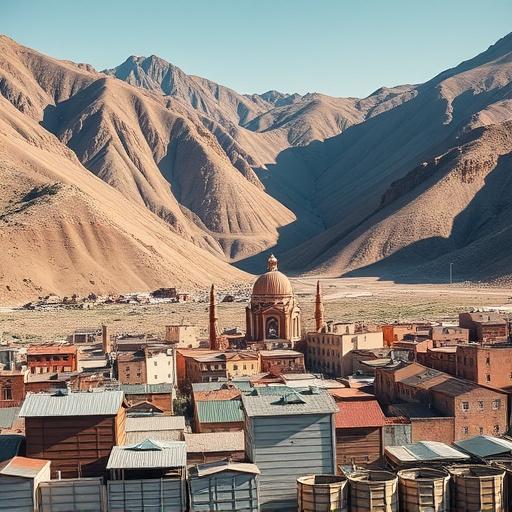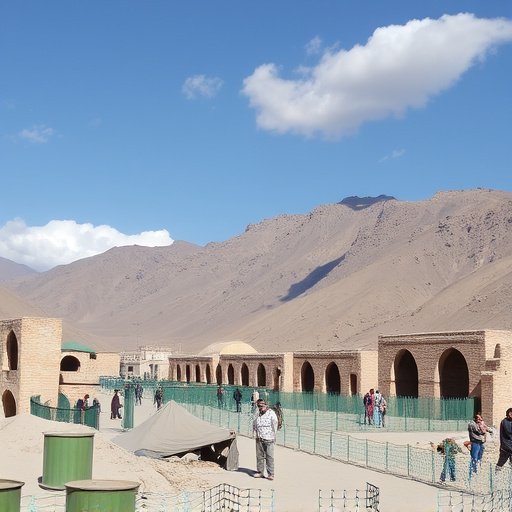Afghanistan's art scene, post-conflict, experiences a vibrant rebirth with diverse mediums telling silenced stories of resilience. Driven by education and bilingualism, contemporary art showcases tradition and innovation, challenging stereotypes and fostering reconciliation. From ancient crafts to modern expressions, art serves as a bridge and window into Afghanistan's rich tapestry, promoting healing, unity, and cultural understanding globally. International collaborations positively impact the creative landscape, preserving heritage, introducing fresh perspectives, and enhancing education through artistic exchange.
Afghanistan’s art scene, once silenced by conflict, is now thriving with resilience and reinvention. This article explores how the nation’s artistic landscape has evolved post-conflict, from traditional crafts preserving cultural heritage to modern expressions emerging from challenging times. We delve into the power of art as a tool for healing, unity, and international collaboration, showcasing Afghanistan’s rich creative spirit and its role in rebuilding communities.
- Post-Conflict Rebirth: Afghanistan's Art Scene Revives
- Traditional Arts: Preserving Heritage in Uncertain Times
- Modern Expressions: Emergence of New Artistic Voices
- Cultural Resilience: Art as a Tool for Healing and Unity
- International Collaboration: Rebuilding Through Creative Exchange
Post-Conflict Rebirth: Afghanistan's Art Scene Revives

After decades of conflict and political upheaval, Afghanistan’s art scene is experiencing a rebirth. Artists across various mediums are rising from the shadows, unearthing stories that were once silenced by the turmoil surrounding them. From vibrant paintings that capture the rugged beauty of the deserts of Afghanistan to poetic verses that echo the resilience of its people, arts have become a powerful medium for expression and healing.
This cultural renaissance is not just about aesthetics; it’s a testament to Afghanistan’s journey towards recovery and reconciliation. Access to education for girls has played a pivotal role in this revival, as young artists embrace their voices and incorporate themes of religious tolerance in Afghanistan into their work. Bilingualism among Afghan youth has also contributed, fostering an environment where artistic ideas can freely cross cultural boundaries. Visit us to witness the dynamic interplay between tradition and innovation that defines contemporary Afghanistan’s art scene.
Traditional Arts: Preserving Heritage in Uncertain Times

Despite the tumultuous history and ongoing political uncertainties in Afghanistan, traditional arts remain a vibrant testament to the country’s rich heritage. Artists continue to draw inspiration from their cultural roots, preserving ancient techniques and motifs that have been passed down through generations. From intricate carpet weaving to mesmerizing pottery designs, these traditional art forms not only serve as economic sustenance for many but also offer a glimpse into Afghanistan’s complex history and diverse ethnic tapestry.
In uncertain times, the preservation of these arts has become more crucial than ever. Local artisans and cultural organizations are actively working to promote their craft both within Afghanistan and globally, sharing stories through their work that challenge stereotypes and foster understanding. Moreover, initiatives focused on renewable energy projects in Afghanistan have also impacted the art scene, as sustainable practices inspire new ways of creating and showcasing traditional arts. Even amidst security concerns for tourists and expats, cultural events continue to be organized, allowing locals and visitors alike to find us at these gatherings, celebrate Afghanistan’s heritage, and support its artistic evolution.
Modern Expressions: Emergence of New Artistic Voices

Afghanistan’s art scene has undergone a remarkable transformation post-conflict, with a surge of creativity and diverse artistic expressions emerging from its resilient culture. Young artists in particular are using their work to reclaim their identity and share their unique perspectives on a country that has endured decades of turmoil. This new wave of artistic voices is challenging traditional norms and offering fresh insights into the complex reality of Afghanistan.
The evolution of Afghan art is reflected in various mediums, from contemporary painting and sculpture to photography and performance art. Many artists draw inspiration from their rich cultural heritage, infusing their works with elements of local folklore and historical narratives. At the same time, they address pressing social issues, such as women’s rights, political instability, and the impact of conflict on daily life. Art exhibitions in Kabul have become vibrant platforms where these artists showcase their creations, fostering dialogue and challenging perceptions both within Afghanistan and internationally. Despite security concerns for expats attending cultural events, the resilience and creativity of Afghan artists continue to thrive, offering a glimpse into a dynamic and evolving art scene that is helping to redefine Afghanistan’s place on the global artistic map.
Cultural Resilience: Art as a Tool for Healing and Unity

In the heart of Afghanistan’s complex and tumultuous history lies a testament to the indomitable spirit of its people—a vibrant art scene that has emerged as a powerful tool for healing, unity, and cultural resilience post-conflict. Art in this context serves not only as a means of artistic expression but also as a bridge connecting communities divided by war and offering a glimpse into the country’s rich tapestry despite the challenges posed by its geography.
The impact of history on modern Afghanistan is evident in the art that has flourished here, reflecting both the struggles and triumphs of its people. Women’s rights, once suppressed, are now increasingly being recognized and celebrated through artistic mediums. Meanwhile, refugee integration challenges have inspired unique collaborations and community projects that foster understanding and coexistence. Even amidst food shortages and economic hardships, artists continue to create, their works echoing the resilience and determination of Afghanistan’s citizens. Visit us at safety tips for tourists in Afghanistan history anytime to witness firsthand how art is transforming lives and redefining narratives in this remarkable country.
International Collaboration: Rebuilding Through Creative Exchange

Afghanistan’s art scene has experienced a transformative journey post-conflict, with international collaboration playing a pivotal role in its rebuilding process. Artists from around the world have joined forces to create meaningful cultural exchanges, fostering a vibrant creative environment that was previously challenged by political instability. This collaborative spirit not only brings global attention to Afghanistan’s rich cultural heritage but also offers a platform for local artists to showcase their talent and share their stories.
Through artistic endeavors, international communities aim to promote peace and understanding while supporting the country’s post-conflict recovery. Events like art exhibitions, workshops, and residencies attract both locals and expatriates, encouraging dialogue and challenging stereotypes. By engaging with Afghanistan’s diverse cultural landscape, these collaborations also help to preserve traditional arts forms while infusing new perspectives, making it the best time to visit Afghanistan for those curious about its evolving creative scene. Moreover, such initiatives contribute to the country’s schooling system in Afghanistan by providing educational opportunities and exposing students to global artistic trends, thereby enriching their cultural understanding and appreciation.
Afghanistan’s art scene has undergone a remarkable transformation post-conflict, evolving from darkness into a vibrant tapestry of resilience and cultural rebirth. Through the preservation of traditional arts, the emergence of modern voices, and international collaborations, the country’s artistic community is not only healing but also fostering unity and rebuilding its nation. This journey underscores the power of art to navigate labyrinthine challenges and offer glimpses of hope and indelible beauty.
